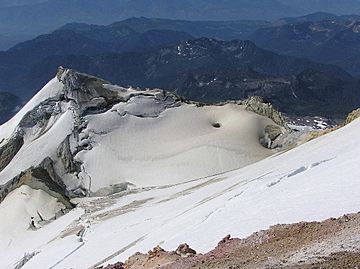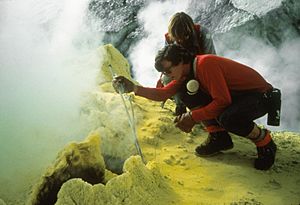Sherman Crater facts for kids
Quick facts for kids Sherman Crater |
|
|---|---|

View south into Sherman Crater from Grant Peak in 2004. Sherman Peak at left; fumaroles of west rim at right.
|
|
| Highest point | |
| Elevation | 9,465 ft (2,885 m) |
| Geography | |
| Location | Whatcom County, Washington, U.S. |
| Parent range | Cascade Range |
| Topo map | USGS Mount Baker |
| Geology | |
| Volcanic arc | Cascade Volcanic Arc |
| Last eruption | September 7 to November 27, 1880 |
Sherman Crater is an active volcanic crater on Mount Baker in the U.S. state of Washington. It sits between Sherman Peak and Grant Peak. This crater is a key part of Mount Baker's volcanic system.
Contents
Mount Baker's Past Eruptions
Mount Baker has erupted many times from Sherman Crater. The first recorded eruption was in 1843. More eruptions happened in 1852–1853, 1854, 1858, 1859–1860, 1863, 1870, and 1880.
These eruptions were rated 2 or 3 on the Volcanic Explosivity Index. This index measures how big volcanic eruptions are. A higher number means a bigger eruption. Some other possible eruptions might have happened too.
The 1975 Activity
In March 1975, people noticed something new at Sherman Crater. A dark column of ash and steam rose from the crater. This was different from the usual white steam. Over the next year, small ash clouds caused mudflows near the crater. These mudflows are like fast-moving rivers of mud and rock.
Scientists also found a big increase in heat coming from the crater. They also found volcanic gases. This made them worried that an eruption might happen. This was the first sign of volcanic activity in the Cascade Range since 1917.
Changes at the Crater
By the fall of 1975, the glacier inside Sherman Crater started melting. This created a large area without snow. It also showed a shallow lake inside the crater. Scientists also found new fumaroles. Fumaroles are vents that release steam and gases from inside the Earth.
Protecting Nearby Areas
A big worry was that an eruption could make the crater walls collapse. This could send huge mudflows into Baker Lake reservoir. Such a mudflow might cause a giant wave to go over the Upper Baker Dam. This would send a lot of water rushing into another reservoir, Lake Shannon. It could then damage or break the Lower Baker Dam.
If the Lower Baker Dam broke, it would cause major flooding down the Skagit River. The town of Concrete is right below this dam. This was a very serious concern.
How Scientists Monitored the Volcano
Because of these worries, scientists used every tool they had to watch Mount Baker. They lowered the water level in Baker Lake reservoir. This was to make space for any possible mudflows. This was the first time a Cascade volcano was watched so closely with modern tools.
Scientists set up a network to detect earthquakes. They measured how the ground tilted. They also checked temperatures and collected gas samples from the fumaroles. They analyzed the meltwater from the crater. All these measurements helped them understand what was happening inside the volcano.
What Happened Next
Over time, scientists did not see clear signs of magma rising. Magma is molten rock from deep inside the Earth. There were no big changes in the gases or ground movement either. The volcanic activity slowly went down over the next two years. However, the amount of heat coming from the ground stayed higher than before 1975.
Scientists continued to watch Mount Baker. The information they collected suggests that magma might have moved under the volcano in 1975. But it did not have enough energy to erupt. This magma likely cooled down. It heated the water system underground, which caused the extra heat and gas.
![]() This article incorporates public domain material from websites or documents of the United States Geological Survey.
This article incorporates public domain material from websites or documents of the United States Geological Survey.



